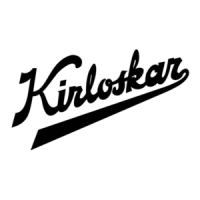Do you have a question about the KIRLOSKAR RKB and is the answer not in the manual?
Details general safety information, manual reading, and compliance with procedures.
Advises against loose clothing and specifies safety gear for specific hazards.
Warns against misuse, improper handling, and explains hazard symbols.
Covers safe practices for transporting, handling, and storing the pump unit.
Covers installation, referencing external manual and detailing alignment types.
Lists essential checks to perform before starting the pump for safe and efficient operation.
Guides on starting the pump, monitoring operation, and managing running conditions.
Procedure for safely stopping the pump, including valve closure and motor stop.
Lists available 'RKB' pump models and their maximum number of stages.
Details bearing specifications, temperature limits, and lubrication guidelines.
Describes stuffing box sealing, packing, lantern ring, and O-ring specifications.
Provides key sizes, oil seal specs, washer dimensions, and tie bar nut torques.
Outlines checks for daily, periodical, and annual maintenance, including overhaul procedures.
Provides step-by-step instructions for dismantling the pump, covering various components.
Procedure for re-assembling the pump, including cleaning parts and specific instructions for pump types.
Details specific steps for re-assembling gland packed pumps, focusing on bearings and lock nuts.
Details specific steps for re-assembling mechanical seal pumps, focusing on seal operating length.
Lists spare parts for RKB pumps with part codes, descriptions, and quantities.
Guidance on pump placement, foundation requirements, and initial alignment procedures.
Details flexible coupling function, alignment checks, and foundation grouting process.
Covers suction/delivery piping, vacuum lines, foot-valves, and stuffing box/bearing maintenance.
Explains priming methods, pump starting sequence, and safe stopping procedures.
Identifies issues related to suction pipe, lift, layout, and air leaks as common pump problems.
Covers problems like clogged or damaged impellers, and worn casing rings.
Addresses worn bearings, incorrect lubrication, and improper fitting as causes of pump issues.
Identifies faulty coupling alignment or wear as causes of pump problems.
Covers problems related to unbalanced or touching rotor parts, and bent shafts.
Addresses pump suitability, voltage problems, motor issues, and delivery flow.
Details general safety information, manual reading, and compliance with procedures.
Advises against loose clothing and specifies safety gear for specific hazards.
Warns against misuse, improper handling, and explains hazard symbols.
Covers safe practices for transporting, handling, and storing the pump unit.
Covers installation, referencing external manual and detailing alignment types.
Lists essential checks to perform before starting the pump for safe and efficient operation.
Guides on starting the pump, monitoring operation, and managing running conditions.
Procedure for safely stopping the pump, including valve closure and motor stop.
Lists available 'RKB' pump models and their maximum number of stages.
Details bearing specifications, temperature limits, and lubrication guidelines.
Describes stuffing box sealing, packing, lantern ring, and O-ring specifications.
Provides key sizes, oil seal specs, washer dimensions, and tie bar nut torques.
Outlines checks for daily, periodical, and annual maintenance, including overhaul procedures.
Provides step-by-step instructions for dismantling the pump, covering various components.
Procedure for re-assembling the pump, including cleaning parts and specific instructions for pump types.
Details specific steps for re-assembling gland packed pumps, focusing on bearings and lock nuts.
Details specific steps for re-assembling mechanical seal pumps, focusing on seal operating length.
Lists spare parts for RKB pumps with part codes, descriptions, and quantities.
Guidance on pump placement, foundation requirements, and initial alignment procedures.
Details flexible coupling function, alignment checks, and foundation grouting process.
Covers suction/delivery piping, vacuum lines, foot-valves, and stuffing box/bearing maintenance.
Explains priming methods, pump starting sequence, and safe stopping procedures.
Identifies issues related to suction pipe, lift, layout, and air leaks as common pump problems.
Covers problems like clogged or damaged impellers, and worn casing rings.
Addresses worn bearings, incorrect lubrication, and improper fitting as causes of pump issues.
Identifies faulty coupling alignment or wear as causes of pump problems.
Covers problems related to unbalanced or touching rotor parts, and bent shafts.
Addresses pump suitability, voltage problems, motor issues, and delivery flow.
| Brand | KIRLOSKAR |
|---|---|
| Model | RKB |
| Category | Water Pump |
| Language | English |











